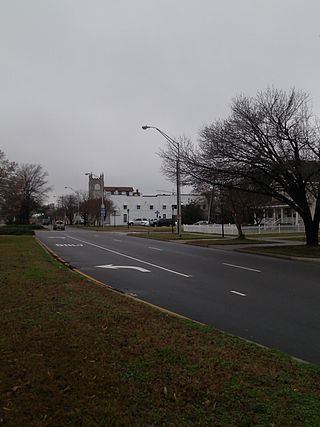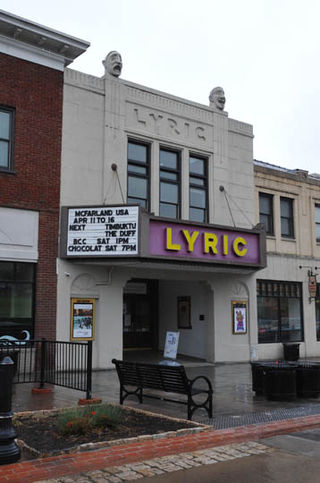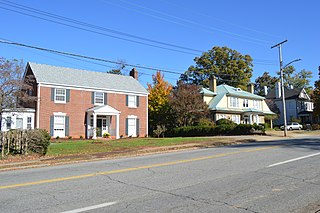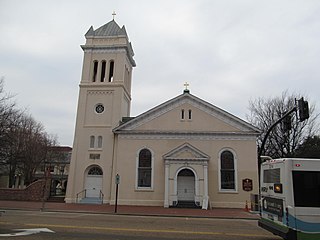
Berkley was an incorporated town in Norfolk County, Virginia. Chartered by an Act of Assembly in 1890, the Town of Berkley was located directly across the Eastern Branch Elizabeth River from the City of Norfolk in the South Hampton Roads area.

Farmville Historic District is a national historic district located at Farmville, Prince Edward County, Virginia. It encompasses 246 contributing buildings and 1 contributing object in the central business district and surrounding residential areas of Farmville. It includes a variety of commercial, residential, institutional, and industrial buildings dating from the mid-19th to early-20th centuries. Notable buildings include the Paulett-Gill house, Farmville Presbyterian Church, Johns Memorial Episcopal Church (1881), Farmville Methodist Church (1907), Hotel Weyanoke (1925), the warehouses of the Dunnington Tobacco Company and Central Virginia Processing, Inc., the former Craddock-Terry Shoe Company, the former Cunningham and Company tobacco prizery, Norfolk and Western Railroad passenger station, Doyne Building, the Watkins M. Abbitt Federal Building (1917), Prince Edward County Courthouse, and the former Farmville High School (1913). Located in the district is the separately listed First Baptist Church.

The Clarksville Historic District is a national historic district located at Clarksville, Mecklenburg County, Virginia. It encompasses 171 contributing buildings, 2 contributing sites, and 1 contributing structure in the central business district and surrounding residential areas of the town of Clarksille. Notable buildings include the Planters Bank (1909), Planters Brick Tobacco Sales Warehouse, Gilliland Hotel, the Russell's Furniture, former Clarksville High School (1934), Clarksville Presbyterian Church, Mount Zion Baptist Church, Jamieson Memorial Methodist Episcopal Church (1901), St. Timothy's Episcopal Church (1917), and St. Catherine of Siena Roman Catholic Church (1947). Located in the district are the separately listed Clark Royster House and the Judge Henry Wood Jr. House.

West Point Historic District is a national historic district located at West Point, King William County, Virginia. The district encompasses 75 contributing buildings and 1 contributing object in the town of West Point. The district includes residential, commercial, and institutional buildings and is notable for its variety of late-19th- and early-20th-century styles and building types. Notable buildings include the William Mitchell House, Anderson-Mayo House, Ware House, St. John's Episcopal Church (1882), Mt. Nebo Baptist Church (1887), West Point United Methodist Church (1889), O'Connor Hotel and annex, Treat-Medlin House (1898), Gouldman House (1923), First Baptist Church (1926), U.S. Post Office (1931), West Point Town Office Building, Citizens and Exchange Bank (1923), and Beverly Allen School (1930s).

Culpeper Historic District is a national historic district located at Culpeper, Culpeper County, Virginia, United States.

Marshall Historic District is a national historic district located at Marshall, Fauquier County, Virginia. It encompasses 314 contributing buildings and 3 contributing sites in the rural village of Marshall. The district represents a collection of historic buildings with a wide range of building types and architectural styles that date from the end of the 18th century to the mid-20th century. Notable buildings include the Fauquier Heritage and Preservation Foundation building, hosteller's house for Rector's Ordinary, a store and Confederate post office, the Elgin House, former Marshall Pharmacy, the Foley Building, the Gothic Revival style Trinity Episcopal Church (1849), Salem Baptist Church (1929), Marshall United Methodist Church (1899), and the Marshall Ford Company (1916), reputed to be the oldest building built as a Ford dealership in the United States that is still functioning as such.
Pearisburg Historic District is a national historic district located at Pearisburg, Giles County, Virginia. It encompasses 18 contributing buildings and 1 contributing site in the town of Pearisburg, county seat of Giles County. The district is centered on the Public Square and includes a mix of commercial, institutional, and governmental buildings. Notable buildings include the First National Bank of Pearisburg (1906), Western Hotel, Pearis Theater (1940), Giles County Sheriff's Office and Jail (1937–38), St. Elizabeth Hospital Building (1920), Giles County Motor Company Building (1923–1924), and Christ Episcopal Church (1910). The Giles County Courthouse is listed separately.

Town of Halifax Court House Historic District is a national historic district located at Halifax, Halifax County, Virginia. The district includes 172 contributing buildings, 1 contributing site, 13 contributing structures, and 1 contributing object in the Town of Halifax. Resources include government, commercial, residential, religious, educational and industrial buildings that date from the early-19th Century to the mid-20th century. Notable buildings include the Rice House, Edmunds/Lewis Office (1869), People's Bank, Beth Car Baptist Church (1892), Christ Episcopal Church, Saint Luke's Christian Methodist Episcopal Church, Dr. Carter House, County Office Building (1915), Town of Halifax Swimming Pool (1930s), Municipal Building/ Fire Station (1950), Halifax Roller Mills (1915), Halifax Planing Mill, Halifax Department Store (1949), and Randolph Theater. Also located in the district is the separately listed Halifax County Courthouse.

Blacksburg Historic District is a national historic district located at Blacksburg, Montgomery County, Virginia. The district encompasses 137 contributing buildings and 2 contributing sites in the central business district and surrounding residential areas of the town of Blacksburg. The district includes commercial, residential, and institutional buildings in a variety of popular architectural styles including Greek Revival, Gothic Revival, and Colonial Revival. Notable buildings include the Johnson House, Blacksburg Presbyterian Church #1 (1847), Smith-Montgomery House, Croy House, Spout Spring House, Deyerle's Store (1875-1877), W. B. Conway Building, Presbyterian manse (1907), Sheriff Camper House, Christ Episcopal Church, African Methodist Episcopal Church of Blacksburg, Blacksburg Presbyterian Church (1904), Blacksburg Methodist Church (1910), St. Mary's Catholic Church, Hunter's Lodge Masonic Building (1928), Martin-Logan Store, Lyric Theater (1922), and Ellett's Drug Store (1900).

Blackstone Historic District is a national historic district located at Blackstone, Nottoway County, Virginia. It encompasses 272 contributing buildings and 1 contributing structure in the town of Blackstone. They include residential and commercial structures dating from the late-18th to early-20th centuries. They include notable examples of the Late Gothic Revival, Queen Anne, and Romanesque styles. Notable buildings include the former Blackstone College for Girls (1922), First National Bank, Thomas M. Dillard House, Richmond F. Dillard House, Blackstone Public School Complex, Bagley House (1911), James D. Crawley House (1903), Blackstone Baptist Church (1907), Crenshaw United Methodist Church (1903), St. Luke's Episcopal Church (1916), and Blackstone Presbyterian Church (1901). The James D. Crawley House was designed by J. E. McDaniel, who was a local architect. Located in the district is the separately listed Schwartz Tavern.

Glasgow Historic District is a national historic district located at Glasgow, Rockbridge County, Virginia. The district encompasses 43 contributing buildings, 3 contributing sites, and 1 contributing structure in the central business district of the town of Glasgow. It includes a variety of residential, commercial, and institutional buildings dating from the 1820s to 1920s, with most structures from the 1890s. Notable buildings include the Rebecca Salling House, First Baptist Church, the former Glasgow Baptist Church, St. John's Episcopal Church, Blue Ridge Building, and Glasgow Masonic Temple (1891-1892).

Charlottesville and Albemarle County Courthouse Historic District, also known as the Charlottesville Historic District is a national historic district located at Charlottesville, Virginia. The district encompasses the previously listed Albemarle County Courthouse Historic District and includes 269 contributing buildings and 1 contributing object in the city of Charlottesville. It includes the traditional heart of the city's commercial, civic, and religious activities, with early residential development and industrial sites located along the fringe. The commercial core is located along a seven block Downtown Mall designed by Lawrence Halprin (1916-2009). Notable buildings include the Albemarle County Courthouse, Levy Opera House, Number Nothing, Redland Club, Eagle Tavern, United States Post Office and Courts Building (1906), Christ (Episcopal) Church (1895-1898), Beth Israel Synagogue (1882-1903), Holy Comforter Catholic Church (1925), First Methodist Church (1924), McIntire Public Library (1919-1922), and Virginia National Bank (1916). Also located in the district are the separately listed Abell-Gleason House, William H. McGuffey Primary School, Thomas Jonathan Jackson sculpture, Robert Edward Lee sculpture, and Marshall-Rucker-Smith House.

Covington Historic District is a national historic district located at Covington, Virginia. The district encompasses 108 contributing buildings, 1 contributing site, and 1 contributing structure in the historic core of the city of Covington. It includes late-19th and early-20th-century commercial buildings, dwellings that date from around 1820 until 1940, and governmental, educational, religious, industrial, and transportation-related buildings. Notable buildings include Merry Stand, the James Burk House (1824), Callaghan House (1840s), William W. Lawrence House (1850s), Rinehart Building, Covington Savings Bank (1910s), I. O. O. F. Building, Covington Post Office (1914), Hotel Collins (1910), Hippodrome Theater (1920s), C&O Railway and Freight Station (1914-1915), Alleghany County Courthouse (1910), Alleghany County Jail, Sacred Heart Catholic Church, Emmanuel Episcopal Church, First Presbyterian Church (1924), and Covington Baptist Church (1902).

Hampton Downtown Historic District is a national historic district located at Hampton, Virginia. The district encompasses 25 contributing buildings and 7 contributing sites in the central business district of Hampton. The district includes a variety of commercial, residential, institutional, and governmental buildings dating from the late-19th to mid-20th century. There are notable examples of the Beaux-Arts, Art Deco, and Gothic Revival styles. Notable buildings include First United Methodist Church, the Sclater Building (1871), St. Tammany's Masonic Lodge (1888), Hampton Baptist Church (1883), Old Hampton Station Post Office (1914), and the circuit courthouse (1876). Located in the district and separately listed are St. John's Episcopal Church (1728) and the former Hampton City Hall (1939).

East Church Street–Starling Avenue Historic District is a national historic district located at Martinsville, Virginia. It encompasses 117 contributing buildings, 1 contributing structure, and 1 contributing object in a residential section of Martinsville. The buildings range in date from the range in date from the mid-1880s to the mid-1950s and include notable examples of the Tudor Revival and Colonial Revival styles. Notable buildings include the James Cheshire House, the Obidiah Allen House, John W. Carter House (1896), Christ Episcopal Church (1890s), G.T. Lester House or the “Wedding Cake House” (1918), John W. Townes House, Vaughn M. Draper House, and Martinsville High School (1940) and Gymnasium Building (1928). Located in the district are the separately listed John Waddey Carter House, Scuffle Hill, and the Little Post Office.

Trinity Episcopal Church is a historic Episcopal church located in Portsmouth, Virginia. It was built between 1828 and 1830, and is a stuccoed brick building. It has an attached bell tower. Also on the property is the contributing parish house, built in 1887. During the American Civil War, the church was used as a hospital.

Portsmouth Olde Towne Historic District, is a national historic district located at Portsmouth, Virginia. It encompasses 89 buildings. It is located in the primarily residential section of Portsmouth and includes a notable collection of Federal and Greek Revival style townhouses, known as "basement houses." Other notable buildings include the Watts House (1799), Grice-Neeley House, Ball-Nivison House (1752), Emanuel African Methodist Episcopal Church (1857), St. John's Episcopal Church (1898), Court Street Baptist Church (1901-1903), and Union Machinist Home. Located in the district is the separately listed Monumental Methodist Church.

The Brookland Park Historic District is a national historic district located at Richmond, Virginia. The district encompasses 1,157 contributing buildings located north of downtown Richmond and Barton Heights.

The Three Chopt Road Historic District is a national historic district located at Richmond, Virginia. The district encompasses 90 contributing buildings, 4 contributing sites, and 4 contributing structures located west of downtown Richmond. The primarily residential area developed starting in the early-20th century as one of the city's early "streetcar suburbs." The buildings are in a variety of popular late-19th and early-20th century architectural styles including frame bungalows, Colonial Revival, Tudor Revival, and Mission Revival. There are a remarkable group of unusually large, architect-designed houses and churches. Notable non-residential buildings include St. Bridget's Catholic Church (1950) and St. Stephen's Episcopal Church. Located in the district is the separately listed Green's Farm (Huntley).

Downtown Salem Historic District is a national historic district located at Salem, Virginia. The district encompasses 34 contributing buildings and 1 contributing site in downtown Salem. The district includes primarily mixed-use commercial buildings, but also includes churches, dwellings, a courthouse, a post office, a library, a park, and the covered stalls of a farmer's market. The buildings mostly date from the late-19th and early-20th century and are in a variety of popular architectural styles including Greek Revival, Italianate, and Queen Anne. Notable buildings include the Stevens House or "Old Post House" (1820s-1830s), Kizer-Webber Building (1883-1886), Duval-Oakey House (1891-1898), Salem High School, Old Salem Municipal Building and Fire Department (1925), Quality Bakery Building, Olde Newberry Building (1929), Salem Theater, and James J. True Building (1927). Located in the district are the separately listed Old Roanoke County Courthouse, Salem Presbyterian Church, and Salem Post Office.
























